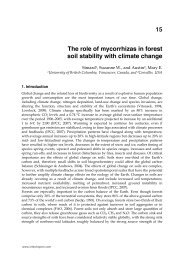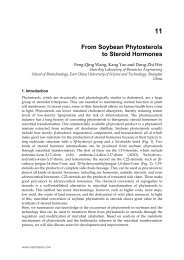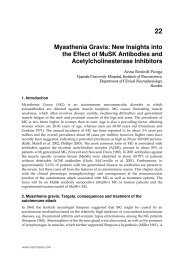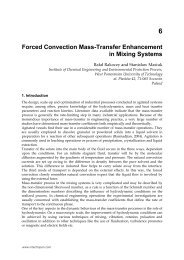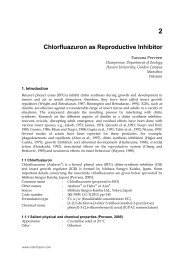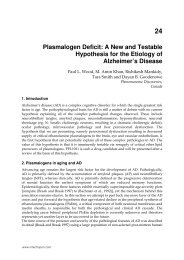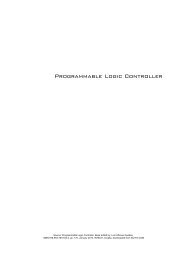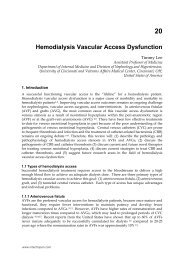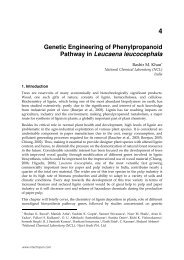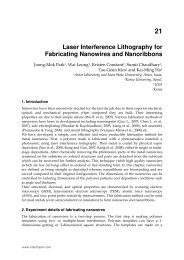Quality Control of Cordyceps sinensis Teleomorph ... - InTech
Quality Control of Cordyceps sinensis Teleomorph ... - InTech
Quality Control of Cordyceps sinensis Teleomorph ... - InTech
Create successful ePaper yourself
Turn your PDF publications into a flip-book with our unique Google optimized e-Paper software.
1. Introduction<br />
12<br />
<strong>Quality</strong> <strong>Control</strong> <strong>of</strong> <strong>Cordyceps</strong> <strong>sinensis</strong><br />
<strong>Teleomorph</strong>, Anamorph, and Its Products<br />
Chih-Sheng Chen, Ruey-Shyang Hseu and Ching-Tsan Huang<br />
National Taiwan University, Taipei<br />
Taiwan,<br />
Republic <strong>of</strong> China<br />
1.1 <strong>Cordyceps</strong> <strong>sinensis</strong> general description and habitat<br />
<strong>Cordyceps</strong> <strong>sinensis</strong> (Berk.) Sacc. is a caterpillar fungus <strong>of</strong> the genus <strong>Cordyceps</strong> (Clavicipitaceae,<br />
Hypocreales, Pyrenomycetes, Ascomycota, Eukaryota) (Fig. 1).<br />
stroma<br />
sclerotium<br />
Fig. 1. The stroma and sclerotium <strong>of</strong> a <strong>Cordyceps</strong> <strong>sinensis</strong> specimen (image with back<br />
shadow)<br />
The fungus is endemic mostly to the alpine shrub-meadow zone <strong>of</strong> high mountains (3000–<br />
5000 m altitude) or highlands <strong>of</strong> the south western <strong>of</strong> China (the Tibet Autonomous Region<br />
and the Qinghai, Sichuan, Yunnan and Gansu provinces) and to some countries <strong>of</strong> the<br />
Himalayan south slope (Nepal, Bhutan, and North East India) (Fig. 2). It grows parasitically<br />
on Lepidoptera larvae, particularly those belonging to the genus Hepialus (bat moths), which<br />
are found in cool weather conditions (Kinjo & Zang, 2001; Pegler et al., 1994).<br />
After host larval infection with either meiotic or mitotic spores, the fungus multiplies in the<br />
host by yeast-like budding, eventually killing the host. The fungus then grows in the form <strong>of</strong><br />
www.intechopen.com
224<br />
<strong>Quality</strong> <strong>Control</strong> <strong>of</strong> Herbal Medicines and Related Areas<br />
thread-like hyphae. Following overwintering, the fungus ruptures the host body, forming a<br />
sexual sporulating structure (a perithecial stroma) that is connected to the dead larva below<br />
ground and grows upward to emerge above the soil surface. It is this stroma, either with or<br />
without the host larva, that is traditionally used for medicinal purposes (Buenz et al., 2005).<br />
Fig. 2. Distribution <strong>of</strong> <strong>Cordyceps</strong> <strong>sinensis</strong> (Buenz et al., 2005)<br />
1.2 Medicinal effects <strong>of</strong> C. <strong>sinensis</strong><br />
In Asia, C. <strong>sinensis</strong> is considered a valuable traditional herb that has several medicinal<br />
effects. It has been reported that C. <strong>sinensis</strong> nourishes the lungs and kidneys (Pegler et al.,<br />
1994), strengthens the immune system (Kuo et al., 1996), revitalizes the body after serious<br />
illness, acts as an aphrodisiac (Bhattarai, 1993), is a free-radical scavenger (Yamaguchi et al.,<br />
2000), exerts an anti-tumour effect (Chen et al., 1997b), and possesses the ability to alter<br />
apoptotic homeostasis (Buenz et al., 2005).<br />
1.3 Morphology <strong>of</strong> the C. <strong>sinensis</strong> teleomorph<br />
C. <strong>sinensis</strong> has a sexual stage (teleomorph) and an asexual stage (anamorph). It is generally<br />
seen in the sexual stage with a stalked fruit body. Recently, an inadequate teleomorph<br />
supply has raised its price to around 30,000–50,000 USD per kilogram (depending on size<br />
and quality). This high price results in many fake products on the market, e.g. other<br />
<strong>Cordyceps</strong> spp. (e.g. C. cicadicola, C. liangshanensis, C. hawkesii, C. militaris, C. ophioglossoides, C.<br />
shanxiensis, C. sobolifera, etc.) or some plant root and stem products; therefore, accurate C.<br />
<strong>sinensis</strong> teleomorph identification is very important (Chen et al., 2009).<br />
www.intechopen.com
<strong>Quality</strong> <strong>Control</strong> <strong>of</strong> <strong>Cordyceps</strong> <strong>sinensis</strong> <strong>Teleomorph</strong>, Anamorph, and Its Products<br />
Species<br />
Hirsutella<br />
<strong>sinensis</strong><br />
C.<br />
liangshanensis<br />
<strong>Cordyceps</strong> sp.<br />
C. memorabilis<br />
C. militaris<br />
C.<br />
ophioglossoides<br />
Isolate<br />
No.<br />
Tissue Locality/Source Collection<br />
date<br />
ITS 18S<br />
Sclerotium<br />
(head)<br />
- May 1997 AJ488243 -<br />
Sclerotium<br />
(tail)<br />
- May 1997 AJ488244 -<br />
Csd Stroma - May 1997 AJ488269 -<br />
Sclerotium<br />
(body)<br />
- May 1997 AJ488270 -<br />
Cs824d Stroma - May 1997 AJ488271 -<br />
229<br />
S1023 Stroma Tibet, China Oct. 1998 AJ488257 AJ274534<br />
Sclerotium<br />
(head)<br />
Tibet, China Oct. 1998 AJ488256 -<br />
Sclerotium<br />
(tail)<br />
Tibet, China Oct. 1998 AJ488258 -<br />
T1023 Stroma Qinghai, China Oct. 1998 AJ488263 AJ274532<br />
Sclerotium<br />
(head)<br />
Qinghai, China Oct. 1998 AJ488261 -<br />
Sclerotium<br />
(tail)<br />
Qinghai, China Oct. 1998 AJ488262 -<br />
H1023 Stroma Qinghai, China Oct. 1998 AJ488254 AJ274535<br />
Sclerotium<br />
(tail)<br />
Qinghai, China Oct. 1998 AJ488255 -<br />
K1023 Stroma - Oct. 1998 AJ488264 AJ274536<br />
Sclerotium<br />
(head)<br />
- Oct. 1998 AJ488265 -<br />
Sclerotium<br />
(tail)<br />
- Oct. 1998 AJ488266 -<br />
RS2 Mycelium Tibet, China May 1997 AJ488275 AJ274540<br />
RS3 Mycelium Tibet, China May 1997 AJ488274 AJ274537<br />
CC1014a Stroma China – – AJ239070<br />
ATCC<br />
36337<br />
Mycelium ATCC – – AJ239076<br />
ATCC<br />
36743<br />
Mycelium ATCC – AJ242432<br />
ATCC<br />
26848<br />
Mycelium ATCC – – AJ239074<br />
CMC2 Stroma China - AJ488277 -<br />
ATCC<br />
36865<br />
Mycelium ATCC – – AJ239075<br />
Table 1. Examined species and isolates and their GenBank nrDNA sequences<br />
www.intechopen.com
230<br />
3. Results<br />
<strong>Quality</strong> <strong>Control</strong> <strong>of</strong> Herbal Medicines and Related Areas<br />
3.1 PCR amplification and DNA sequencing<br />
We amplified and sequenced the NS5/NS6 region and ITS region nrDNA sequences <strong>of</strong> the<br />
<strong>Cordyceps</strong> species collected in our laboratory. Their GenBank Accession Numbers<br />
(http://www.ncbi.nlm.nih.gov/) are provided in Table 1. The ITS region yielded products<br />
<strong>of</strong> approximately 550 bp, while those <strong>of</strong> the NS5/NS6 region were approximately 310 bp.<br />
In the present study, the 18S or ITS nrDNA sequences <strong>of</strong> the stroma and sclerotium (head,<br />
tail, and whole body) from each isolate were identical [Cs7528A(b) vs. Cs7528A(f); W1023(f)<br />
vs. W1023(t); Cs824a(f) vs. Cs824a(b); Cs7528H(f) vs. Cs7528H(h) vs. Cs7528H(t); Cs7528J(f)<br />
vs. Cs7528J(t); K1023(f) vs. K1023(h) vs. K1023(t); H1023(f) vs. H1023(t); T1023(f) vs. T1023(h)<br />
vs. T1023(t); S1023(f) vs. S1023(h) vs. S1023(t); Csd(f) vs. Csd(b); RSCsM(f) vs. RSCsM(h) vs.<br />
RSCsM(t); RSCsL(f) vs. RSCsL(h) vs. RSCsL(t); RSCsK(f) vs. RSCsK(h) vs. RSCsK(t); and<br />
RSCsI(f) vs. RSCsI(h) vs. RSCsI(t)] (Table 1). This result suggested that the stroma and<br />
sclerotium from each isolate originated from the same species.<br />
3.2 Phylogenetic analysis<br />
The phylogenetic tree based on the ITS region sequences is illustrated in Fig. 4. It was<br />
constructed using the sequencing data collected in this study as well as from GenBank. The<br />
C. memorabilis strain ATCC 36743 was set as the out-group. The 3 C. militaris sequences—<br />
GenBank Accession Nos. AJ242923, AJ243774, and CMC2—were grouped.<br />
The C. <strong>sinensis</strong> specimens could be divided into 5 subgroups. Group A included the<br />
following isolates: (1) Tibet isolates Cs824d(f), K1023(f), RS2, Csd(b), and Cs7528A(f) as well<br />
as those with GenBank Accession Nos. AJ243775, AJ243776, AJ243778, AJ243979, AJ243980,<br />
AJ245559, AJ413178, AJ413179, AJ413180, AJ507399, AJ507400, AJ507401, AJ507402, and<br />
AB067713; (2) Sichuan isolates Cs824a(f) and Cs824b(b) as well as those with GenBank<br />
Accession Nos. AJ413183, AJ413184, AB067715, and AB067717; (3) Qinghai isolates T1023(t)<br />
and those with GenBank Accession Nos. AJ413181, AJ413182, and AJ507404; (4) Yunnan<br />
isolates with GenBank Accession Nos. AJ309354, AJ309361, and AJ507403; (5) Gansu isolates<br />
with GenBank Accession Nos. AJ507405 and AB067716; and (6) uncertain locality isolates<br />
with GenBank Accession Nos. AB067718, AB067721, and AJ309357. This group is similar to<br />
subgroup 2 <strong>of</strong> Kinjo and Zang (2001), and the bootstrap level was 994.<br />
Group B included the following isolates: (1) Tibet isolates with GenBank Accession Nos.<br />
AB067739 (isolate Nyaramu-1), AB067740 (isolate Nyaramu-2), AB067743 (isolate<br />
Yagyusan), and AB067744 (isolate Satoku); (2) Sichuan isolates with GenBank Accession<br />
Nos. AB067742 (isolate Ritan), AB067745 (isolate Kandin Clone A1), AB067746 (isolate<br />
Kandin Clone A2), AB067747 (isolate Kandin Clone A4), AB067748 (isolate Kandin Clone<br />
B3), and AB067749 (isolate Kandin Clone B6); and (3) Qinghai isolate with GenBank<br />
Accession No. AB067741 (isolate Rusyasya). This group is close to subgroup 1 <strong>of</strong> Kinjo and<br />
Zang (2001), and the bootstrap level was 1000.<br />
Group C, which we discovered earlier (Chen et al., 2004), included the following: (1) Tibet<br />
isolate Cs1014C(b) and (2) Sichuan isolate W1023(f). The bootstrap level <strong>of</strong> Group C was<br />
1000. Although this group was remote from C. <strong>sinensis</strong> Groups A and B, the 2 isolates were<br />
identified to be C. <strong>sinensis</strong> based on morphological observations.<br />
Group D included the following isolates/strains: GenBank Accession Nos. AF122030 (strain<br />
BCRC 36421), AF291749 (strain MPNU 8002), and AB067720 (isolate SHANGHAI). The<br />
bootstrap level <strong>of</strong> Group D was 1000. Although these isolates were scientifically named C.<br />
www.intechopen.com
<strong>Quality</strong> <strong>Control</strong> <strong>of</strong> <strong>Cordyceps</strong> <strong>sinensis</strong> <strong>Teleomorph</strong>, Anamorph, and Its Products<br />
10<br />
1000<br />
ATCC 36743<br />
912<br />
1000<br />
910<br />
AJ413180<br />
AJ507402<br />
586<br />
AJ413179<br />
693<br />
AJ507401<br />
AJ243778<br />
AJ507400<br />
AJ507399<br />
731<br />
630<br />
677<br />
AJ413178<br />
AJ413183<br />
AJ413181<br />
AJ413182<br />
AJ413184<br />
880<br />
AJ243980<br />
AJ243979<br />
669<br />
AJ245559<br />
AJ243775<br />
K1023(f)<br />
617<br />
AJ507404<br />
AB067715<br />
AB067716<br />
AB067718<br />
AB067721<br />
504<br />
Cs824a(f)<br />
T1023(t)<br />
RS2<br />
Csd(b)<br />
565<br />
Cs824b(b)<br />
Cs7528A(f)<br />
970<br />
AB067717<br />
994<br />
842<br />
AJ507403<br />
AJ243776<br />
AB067713<br />
Cs824d(f)<br />
517<br />
AJ507405<br />
AJ309354<br />
AJ309357<br />
AJ309361<br />
1000<br />
AB067749<br />
AB067742<br />
867<br />
AB067743<br />
AB067745<br />
638<br />
1000<br />
1000<br />
AB067746<br />
AB067747<br />
AB067748<br />
AB067744<br />
AB067741<br />
B<br />
1000<br />
AB067740<br />
AB067739<br />
1000<br />
516<br />
1000<br />
1000<br />
AB067720<br />
AF291749<br />
AF122030<br />
CMC2<br />
AJ243774<br />
AJ242923<br />
D<br />
W1023(f)<br />
Cs1014C(b) C<br />
AB067719<br />
E<br />
Fig. 4. Phylogenetic tree resulting from the Neighbour-Joining Method (NJ) <strong>of</strong> the nrDNA<br />
ITS1, 5.8S, and ITS2 region sequences <strong>of</strong> <strong>Cordyceps</strong> <strong>sinensis</strong> and other related fungi. NJ<br />
bootstrap percentage values are shown at each branch<br />
www.intechopen.com<br />
231<br />
A
<strong>Quality</strong> <strong>Control</strong> <strong>of</strong> <strong>Cordyceps</strong> <strong>sinensis</strong> <strong>Teleomorph</strong>, Anamorph, and Its Products<br />
Obviously, C. <strong>sinensis</strong> had 2 restriction sites—CfoI and RsaI (the signature sequence)—that<br />
could be used to differentiate C. <strong>sinensis</strong> from other <strong>Cordyceps</strong> spp. (Fig. 5). To ensure<br />
specificity <strong>of</strong> the signature sequence, the GenBank database was searched using the search<br />
phrase ’<strong>Cordyceps</strong> 18S rRNA gene’. Simultaneously, the NS5/NS6 region sequence was<br />
uploaded to GenBank and the database was searched for the sequences that were mostly<br />
closely related using the Basic Local Alignment Search Tool (BLAST) program (Altschul et<br />
al., 1990). None <strong>of</strong> the sequences contained both restriction sites (data not shown); thus, C.<br />
<strong>sinensis</strong> could be definitively identified based on the 2 restriction sites.<br />
The PCR-RFLP method based on the signature sequence was developed and used to<br />
characterize C. <strong>sinensis</strong> fermented products in Taiwan (Table 3).<br />
Marketing Sample a Sample Origin b Collection Date<br />
C. <strong>sinensis</strong> mycelium A June 2004<br />
C. <strong>sinensis</strong> mycelium AV June 2004<br />
C. <strong>sinensis</strong> mycelium B June 2004<br />
C. <strong>sinensis</strong> mycelium C June 2004<br />
C. <strong>sinensis</strong> and Ganoderma lucidum mycelia DP June 2004<br />
C. <strong>sinensis</strong> mycelium G1 June 2004<br />
C. <strong>sinensis</strong> mycelium Gen June 2004<br />
C. <strong>sinensis</strong> mycelium L June 2004<br />
C. <strong>sinensis</strong> mycelium NT June 2004<br />
C. <strong>sinensis</strong> mycelium P June 2004<br />
C. <strong>sinensis</strong> mycelium PH June 2004<br />
C. <strong>sinensis</strong> mycelium 4B June 2004<br />
aThe marketing sample content descriptions were provided by the respective suppliers.<br />
bFull company names related to the marketing samples are not shown here.<br />
Table 3. <strong>Cordyceps</strong> <strong>sinensis</strong> mycelium fermented products collected in the present study<br />
Among the 12 fermented products, only AV and L matched the signature sequence and<br />
were, therefore, considered genuine C. <strong>sinensis</strong> mycelium products (Fig. 6).<br />
Another 8 products—A, B, C, G1, Gen, NT, PH, and 4B, none <strong>of</strong> which were digested by CfoI<br />
and RsaI—were considered fake products. The product DP, whose content was labeled C.<br />
<strong>sinensis</strong> and Ganoderma lucidum mycelia, had 2 corresponding polymorphism patterns;<br />
however, the product P, whose content was labeled only as C. <strong>sinensis</strong> mycelium, must not<br />
exclusively comprise pure C. <strong>sinensis</strong> mycelium.<br />
4. Discussion<br />
ITS-region nrDNA, which consists <strong>of</strong> the 2 variable non-coding regions ITS 1 and ITS 2, was<br />
more broadly used in phylogenetic analysis than 18S nrDNA. However, the 2 C. <strong>sinensis</strong>-<br />
www.intechopen.com<br />
233
<strong>Quality</strong> <strong>Control</strong> <strong>of</strong> <strong>Cordyceps</strong> <strong>sinensis</strong> <strong>Teleomorph</strong>, Anamorph, and Its Products<br />
specific probes (Chen et al., 2001b) and the PCR-SSCP method (Kuo et al., 2006; Kuo et al.,<br />
2005) based on the ITS region nrDNA sequence could detect only group A in Fig. 4. Thus,<br />
the 18S nrDNA was used in the present study instead <strong>of</strong> the ITS region to develop a method<br />
by which to differentiate C. <strong>sinensis</strong>.<br />
The signature sequence based on the CfoI and RsaI restriction sites <strong>of</strong> the NS5/NS6 region<br />
was an innovative and species-level genetic marker <strong>of</strong> C. <strong>sinensis</strong>. It could be broadly used to<br />
determine C. <strong>sinensis</strong> teleomorph, anamorph, and the identification and differentiation <strong>of</strong><br />
derivative products. In addition, the C. <strong>sinensis</strong> was further divided into 3 intra-species<br />
groups, based on the ITS-region sequences. These molecular systematic indicators could<br />
serve as the foundation for further research and applications.<br />
Many teleomorph and anamorph fermented products in the market do not comprise C.<br />
<strong>sinensis</strong> (i.e. fake products), and some <strong>of</strong> them are not made exclusively <strong>of</strong> pure C. <strong>sinensis</strong><br />
(Fig. 6). They might be made <strong>of</strong> or mixed with other <strong>Cordyceps</strong> spp.—C. <strong>sinensis</strong>-related<br />
anamorph strains, plant powders, or other materials. Although many <strong>of</strong> these ingredients<br />
were reported as having various biological functions, the fake or impure products, labelled<br />
as ‘C. <strong>sinensis</strong> mycelium products’, might cause serious problems with regards to food<br />
safety. Thus, the signature sequence will be a powerful tool in assaying C. <strong>sinensis</strong> fermented<br />
products and performing quality control measures.<br />
On the basis <strong>of</strong> morphological observation and signature sequence confirmation, strain RS3<br />
was identified as C. <strong>sinensis</strong> anamorph, i.e. H. <strong>sinensis</strong>. According to the ITS-region nrDNA<br />
sequence, it belongs to group A <strong>of</strong> Fig. 4. However, the genomic statuses <strong>of</strong> the anamorph<br />
strains <strong>of</strong> groups B and C remain unclear. Further work should be undertaken to collect live<br />
C. <strong>sinensis</strong> specimens for group B and group C anamorph strain isolation and for research<br />
into the morphological characteristics and medicinal effects <strong>of</strong> each group isolate.<br />
5. Conclusion<br />
In the present study, we successfully developed a molecular method that can detect all 3<br />
sub-species groups <strong>of</strong> C. <strong>sinensis</strong>. This innovative method can be applied to C. <strong>sinensis</strong><br />
teleomorph and anamorph identification and can be used to improve quality control.<br />
6. Acknowledgment<br />
This study was supported by a grant (Grant No. DOH-91-TD-1163) from the Department <strong>of</strong><br />
Health, Executive Yuan, Taiwan, Republic <strong>of</strong> China.<br />
7. References<br />
Altschul, S.F., Gish, W., Miller, W., Myers, E.W., & Lipman, D.J. 1990. Basic local alignment<br />
search tool. Journal <strong>of</strong> Molecular Biology, 215, 403-410<br />
Bhattarai, N.K. 1993. Folk herbal medicines <strong>of</strong> Dolakha District, Nepal. Fitoterapia, 66, 387-<br />
395<br />
Buenz, E.J., Bauer, B.A., Osmundson, T.W., & Motley, T.J. 2005. The traditional Chinese<br />
medicine <strong>Cordyceps</strong> <strong>sinensis</strong> and its effects on apoptotic homeostasis. Journal <strong>of</strong><br />
Ethnopharmacology, 96, 19-29<br />
www.intechopen.com<br />
235
236<br />
<strong>Quality</strong> <strong>Control</strong> <strong>of</strong> Herbal Medicines and Related Areas<br />
Chen, C.S. & Hseu, R.S. 1999. Differentiation <strong>of</strong> <strong>Cordyceps</strong> <strong>sinensis</strong> (Berk.) Sacc. specimen<br />
using restriction fragment length polymorphism <strong>of</strong> 18S rRNA gene. Journal <strong>of</strong> The<br />
Chinese Agricultural Chemistry Society 37: 533-545.<br />
Chen, C.S. & Hseu, R.S. 2002. Differentiation <strong>of</strong> <strong>Cordyceps</strong> <strong>sinensis</strong> (Berk.) Sacc. with 18S<br />
rRNA Gene Sequences. Taiwanese Journal <strong>of</strong> Agricultural Chemistry and Food Science<br />
40: 219-225.<br />
Chen, C.S., Ling, C.H., & Hseu, R.S. 2004. Differentiation <strong>of</strong> <strong>Cordyceps</strong> <strong>sinensis</strong> (Berk.) Sacc.<br />
with Internal Transcribed Spacer1, 5.8S and Internal Transcribed Spacer 2 rRNA<br />
Gene Sequences. Taiwanese Journal <strong>of</strong> Agricultural Chemistry and Food Science, 42, 147-<br />
153<br />
Chen, C.S., Huang, C.T., & Hseu, R.S. 2009. Identification <strong>of</strong> <strong>Cordyceps</strong> <strong>sinensis</strong> by 18S<br />
nrDNA Sequencing and Characterization <strong>of</strong> Fermented Products in Taiwan. Food<br />
Biotechnology, 23, 1-9<br />
Chen, Q.-T., Xiao, S.R., & Shi, Z.-Y. 1984. Paecilomyces <strong>sinensis</strong> sp. nov. and its connection<br />
with Cordceps <strong>sinensis</strong>. Acta Mycologica Sinica, 3, 24-28<br />
Chen, Y.-Q., Wang, N., Qu, L.-Q., Li, T.-H., & Zhang, W.-M. 2001a. Determination <strong>of</strong> the<br />
anamorph <strong>of</strong> <strong>Cordyceps</strong> <strong>sinensis</strong> inferred from the analysis <strong>of</strong> the ribosomal DNA<br />
internal transcribed spacers and 5.8S rDNA. Biochemical Systematics and Ecology, 29,<br />
597-607<br />
Chen, Y., Zhang, Y.P., Yang, Y., & Yang, D. 1999. Genetic diversity and taxonomic<br />
implication <strong>of</strong> <strong>Cordyceps</strong> <strong>sinensis</strong> as revealed by RAPD markers. Biochemical Genetics,<br />
37, 201-213<br />
Chen, Y., Wang, W., Yang, Y., Su, B., Zhang, Y., Xiong, L., He, Z., Shu, C., & Yang, D. 1997a.<br />
[Genetic divergence <strong>of</strong> <strong>Cordyceps</strong> <strong>sinensis</strong> as estimated by random amplified<br />
polymorphic DNA analysis]. Yi Chuan Xue Bao, 24, 410-416<br />
Chen, Y.J., Shiao, M.S., Lee, S.S., & Wang, S.Y. 1997b. Effect <strong>of</strong> <strong>Cordyceps</strong> <strong>sinensis</strong> on the<br />
proliferation and differentiation <strong>of</strong> human leukemic U937 cells. Life Sciences, 60,<br />
2349-2359<br />
Chen, Y.Q., Wang, N., Qu, L., Li, T., & Zhang, W. 2001b. Determination <strong>of</strong> the anamorph<br />
<strong>of</strong> <strong>Cordyceps</strong> <strong>sinensis</strong> inferred from the analysis <strong>of</strong> the ribosomal DNA internal<br />
transcribed spacers and 5.8S rDNA. Biochemical Systematics and Ecology, 29, 597-<br />
607,<br />
Egger, K.N. & Sigler, L. 1992. Using molecular data to infer anamorph-teleomorph<br />
connection: the case <strong>of</strong> Scytalidium vaccinii and Hymenoscyphus aricae in the fungal<br />
holomorph: mitotic, meiotic and pleomorphic speciation in fungal systematics CAB<br />
International, Wallingford. pp.<br />
Hall, T.A. 1999. BioEdit: a user-friendly biological sequence alignment editor and analysis<br />
program for Windows 95/98/NT. Nucleic Acids Symposium Series, 41, 95-98,<br />
Hodge, K.T.; Krasn<strong>of</strong>f, S.B., & Humber, R.A. 1996. Tolypocladium inflatum is the anamorph <strong>of</strong><br />
<strong>Cordyceps</strong> subsessils. Mycologia, 88, 715-719<br />
Kinjo, N. & Zang, M. 2001. Morphological and phylogenetic studies on <strong>Cordyceps</strong> <strong>sinensis</strong><br />
distributed in southwestern China. Mycoscience, 42, 567-574,<br />
Kobayasi, Y. 1982. Key to the taxa <strong>of</strong> the genus <strong>Cordyceps</strong> and Torrubiella. Transactions <strong>of</strong> the<br />
Mycological Society <strong>of</strong> Japan, 23, 329-364<br />
www.intechopen.com
<strong>Quality</strong> <strong>Control</strong> <strong>of</strong> <strong>Cordyceps</strong> <strong>sinensis</strong> <strong>Teleomorph</strong>, Anamorph, and Its Products<br />
Kuo, H.-C., Su, Y.-L., Yang, H.-L., Huang, I.-C., & Chen, T.-Y. 2006. Differentiation <strong>of</strong><br />
<strong>Cordyceps</strong> <strong>sinensis</strong> by a PCR-Single-Stranded Conformation Polymorphism Based<br />
Method and Characterization <strong>of</strong> the Fermented Products in Taiwan. Food<br />
Biotechnology, 20, 161-170<br />
Kuo, H.C., Su, Y.L., Yang, H.L., & Chen, T.Y. 2005. Identification <strong>of</strong> Chinese medicinal<br />
fungus <strong>Cordyceps</strong> <strong>sinensis</strong> by PCR-single-stranded conformation polymorphism and<br />
phylogenetic relationship. Taiwanese Journal <strong>of</strong> Agricultural Chemistry and Food<br />
Science, 53, 3963-3968<br />
Kuo, Y.C., Tsai, W.J., Shiao, M.S., Chen, C.F., & Lin, C.Y. 1996. <strong>Cordyceps</strong> <strong>sinensis</strong> as an<br />
immunomodulatory agent. The American Journal <strong>of</strong> Chinese Medicine, 24, 111-125,<br />
Li, C.-L. 1988. A study <strong>of</strong> Tolypocladium <strong>sinensis</strong> Z. L. Li sp. nov and cyclosporin production.<br />
Acta Mycologica Sinica, 7, 93-98<br />
Li, Z.-L. & Sun, Y.-H. 1988. A new species <strong>of</strong> Scytalidium-Scytalidium helpiali. Acta Mycologica<br />
Sinica, 7, 23-28<br />
Li, Z.-Z., Huang, B., & Mei-Zhen, F. 2000. Molecular Evidence for Anamorph Determination<br />
<strong>of</strong> <strong>Cordyceps</strong> <strong>sinensis</strong> (Berk.) Sacc. Mycosystema, 19, 60-64<br />
Liang, Z.-Q. 1991a. A new species <strong>of</strong> Chrysosporium from <strong>Cordyceps</strong> <strong>sinensis</strong> (Berk.) Sacc. Acta<br />
Mycologica Sinica, 10,<br />
Liang, Z.Q. 1991b. Anamorphs <strong>of</strong> <strong>Cordyceps</strong> and determination <strong>of</strong> the relationship between<br />
anamorph and teleomorph. Journal <strong>of</strong> Southwest Agriculture, 4, 1-8<br />
Liu, X.J., Guo, Y.L., Yu, Y.X., & Zeng, W. 1989. Isolation and identification <strong>of</strong> the anamorphic<br />
stage <strong>of</strong> <strong>Cordyceps</strong> <strong>sinensis</strong> (Berk.) Sacc. Acta Mycologica Sinica, 8, 35-40<br />
Liu, Z.-Y., Yao, Y.-J., Liang, Z.Q., Pegler, D.N., & Chase, M.W. 2001. Molecular evidence for<br />
the anamorph-teleomorph connection in <strong>Cordyceps</strong> <strong>sinensis</strong>. Mycological Research,<br />
105, 827-832<br />
Moncalvo, J.M., Wang, H.H., & Hseu, R.S. 1995. Gene phylogeny <strong>of</strong> the Ganoderma lucidum<br />
complex based on ribosomal DNA sequences. Comparison with traditional<br />
taxonomic characters. Mycological Research, 99, 1489-1499<br />
Pegler, D.N., Yao, Y.J., & Li, Y. 1994. The Chinese 'caterpillar fungus'. The Mycologist, 8, 3-5,<br />
Shen, N.-Y. 1983. Brief account <strong>of</strong> research on <strong>Cordyceps</strong> <strong>sinensis</strong>. Medicinal Fungi, 1-2, 85, 88,<br />
Stensrud, Ø., Schumacher, T., Shalchian-Tabrizi, K., Svegarden, I.B., & Kauserud, H. 2007.<br />
Accelerated nrDNA evolution and pr<strong>of</strong>ound AT bias in the medicinal fungus<br />
<strong>Cordyceps</strong> <strong>sinensis</strong>. Mycological Research, 111, 409-415<br />
Thompson, J.D., Higgins, D.G., & Gibson, T.J. 1994. CLUSTAL W: improving the sensitivity<br />
<strong>of</strong> progressive multiple sequence alignment through sequence weighting, positionspecific<br />
gap penalties and weight matrix choice. Nucleic Acids Research, 22, 4673-<br />
4680<br />
White, T.J., Bruns, T., Lee, S., & Taylor, J. 1990. Amplification and direct sequencing <strong>of</strong><br />
fungal ribosomal DNA for phylogenetics. In: PCR Protocols: a Guide to Methods and<br />
Applications. M. A. Innis, D. H. Gelfand, J. J. Sninsky, & T. J. White (eds.), 315-322,<br />
Academic Press, Inc., San Diego, California.<br />
Yamaguchi, Y., Kagota, S., Nakamura, K., Shinozuka, K., & Kunitomo, M. 2000. Antioxidant<br />
activity <strong>of</strong> the extracts from fruiting bodies <strong>of</strong> cultured <strong>Cordyceps</strong> <strong>sinensis</strong>.<br />
Phytotherapy Research, 14, 647-649<br />
www.intechopen.com<br />
237
238<br />
<strong>Quality</strong> <strong>Control</strong> <strong>of</strong> Herbal Medicines and Related Areas<br />
Yin, X.-C. & Shen, L.-Y. 1990. The conidial state <strong>of</strong> <strong>Cordyceps</strong> <strong>sinensis</strong> (Berk.) Sacc.<br />
Synnematium sinense Yin et Shen, sp. nov. Acta Biologica Plateau Sinica, 9, 1-5<br />
Zang, M. & Kinjo, N. 1996. Type study on the <strong>Cordyceps</strong> <strong>sinensis</strong>. Acta Botanica Yunnanica, 17,<br />
63-65<br />
www.intechopen.com




